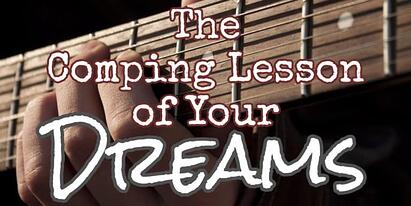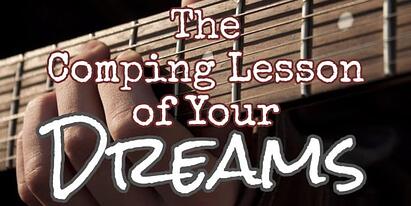
The Jazz Guitar Comping Video Lesson of Your Dreams
Jun 14, 2016Oh yeah! This is exciting. Time for the jazz guitar comping video lesson of your dreams.
No kidding!
The Gist of It
Problem: jazz guitar apprentice is seeking to get better at jazz guitar comping
Solution: first reflex is to try and learn more jazz guitar chord shapes. Which does not work, by the way ... it leads to more confusion.
Alternative: Learn to approach comping from a melodic perspective, taking the top note of each chord as a melody. Then activating this with nice rhythms.
Result: We realize we don't need that many chord shapes to play good jazz guitar comping! ;-)
So, in this lesson, we'll build chords from the top down, starting with the melody note (on the higher strings). In five steps, we'll have a complete, swinging and beautiful comping study on the blues in Bb. A great place to start if you wish to comp like the pros. :-)
Jazz Guitar Comping: Not So Fast!
Here's is the PDF file for the exercises in this lesson.
Jazz Guitar Comping: Let's Go!
This is somewhat of an unconventional guide to jazz guitar comping since we'll be taking a detour. As described above won't be thinking purely in terms of chords. Memorizing tons of new jazz chords often leads to confusion.
[Tweet "Memorizing tons of new jazz chords often leads to confusion."]
This is where I step in as an instructor. To make comping and jazz harmony work we need a different approach. We'll start to examine chords from a melodic perspective. So let's start with a simple melody on the top strings and harmonize a selection of tasty chords under it, then activate the rhythms.
By the end of this post, you'll be playing a complete, beautiful and swinging jazz guitar comping study on the blues in B flat. In five concrete steps you will become a different musician and realize how few shapes you really need in order to make comping sound way better.
The Bb Blues Form (in jazz)
Please take a quick look at the first page of the PDF file . We have the basic chord structure for the basic blues in B flat, as played by jazz musicians.
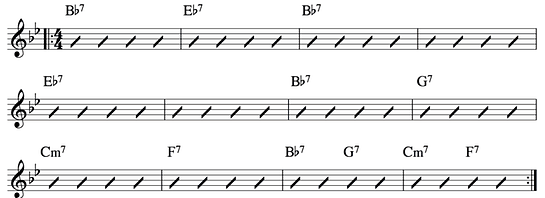
You can hear this in the backing track and with drums and bass only playing three choruses of the blues in B flat. It's usually best to think of the twelve bar blues as three sections of four bars.
The first four bars are around the tonic, in this case B flat seven.
The next four bars are around the four chords, the E flat seven.
And the last four, they contain the II-V-I cadence. If all of this is completely unfamiliar to you, please find further information in the blues section of the JazzGuitarLessons.net website.
Step 1: Just the Melody
Looking at a PDF now in step one, we have the skeleton of the top note melody line we'll use to construct the comping on the blues. Notice that this line is based around the first and fifth degrees of most of the chords in the form.
Learn this!
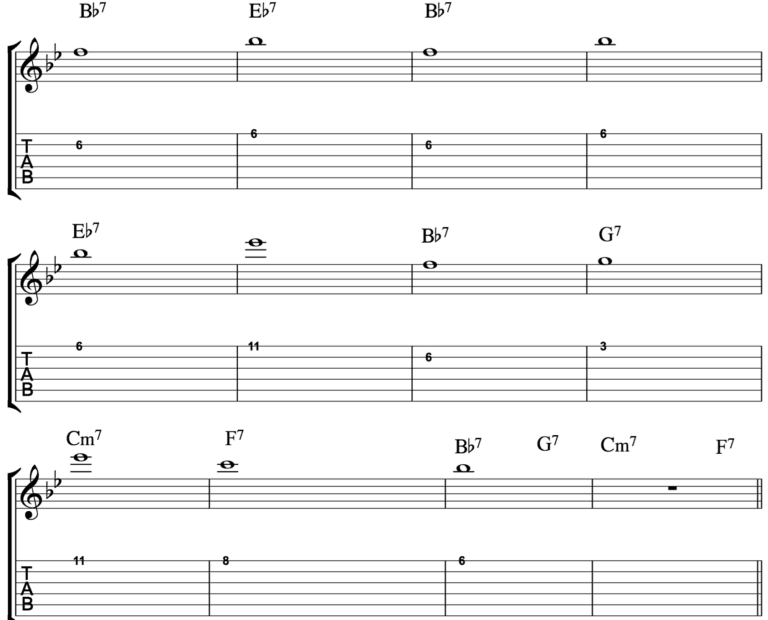
Step 2: Basic (Boring) Chords Added
Let's start using some chords! Notice that what we find in step two, there's just chords with basic barre idea, with a top note as the highest pitch in the chord. Basic barres are the ones you find in your first guitar lessons.
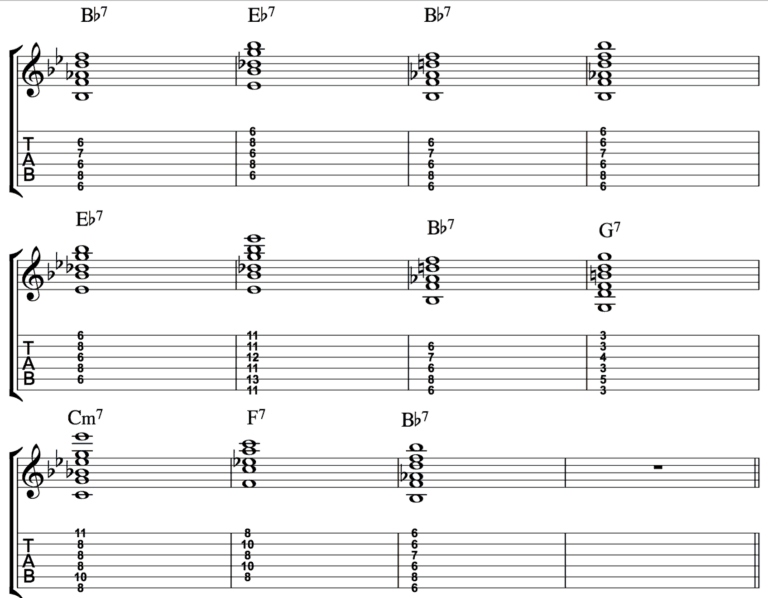
Rootless Jazz Chords with 9ths and 13ths
Step two was pretty boring and not very jazz sounding. Now, let's modify the barre chords to add even more interesting jazz chords. Before you attempt the chords in step 3, let's look review some of the chord shapes we'll be using. They're all rootless voicings, very idiomatic in the jazz guitar world.
First, here's how we play the B flat seven chord, the B flat chord. It has a nine in it and it has no root.
Bb9 = x5656x
We'll also use the same shape in bar eight for the G seven chord. It's the same shape but three frets lower.
G9 = x2323x
Then there's also the B flat thirteen that we'll play in bar four and eleven here. The tonic of the chord is on the top string.
Bb13 = xx6786
Now let's check out this E flat nine chord, the one we have in second bar.
Eb9 =xx5666
It's a same shape here as we we will use in bar ten for the F chord, two frets high.
F9 = xx7888
Lastly there's this interesting E flat nine chord. That we need during bar six.
Eb9 = xx 11 10 8 11
Play Step 3: All Rootless!

Step 4: Adding Rhythms
Great, so now that we have some interesting chords, we need some interesting rhythms to activate the comping. As you probably already know, rhythms and groove are really the true driving force of jazz music.
It doesn't matter if you know a thousand chord shapes.
Once again, it don't mean a thing if it ain't got that swing! In step four most our fancy jazz chords from the previous step have been activated by playing them as an anticipation taking place on the beat and of four right before beat one. That's a push, a swing push.
We also have added one more melody note right before each of the ones found in steps 1-2-3 above, just look at the sheet music. Be careful though, we do this for the first eight bars, but the last four bars have a slightly different rhythm and timing.
The aim is to create a contrast and interest. Since we don't need any new chords, I recommend practicing this step 4 along with the video. Here it is:
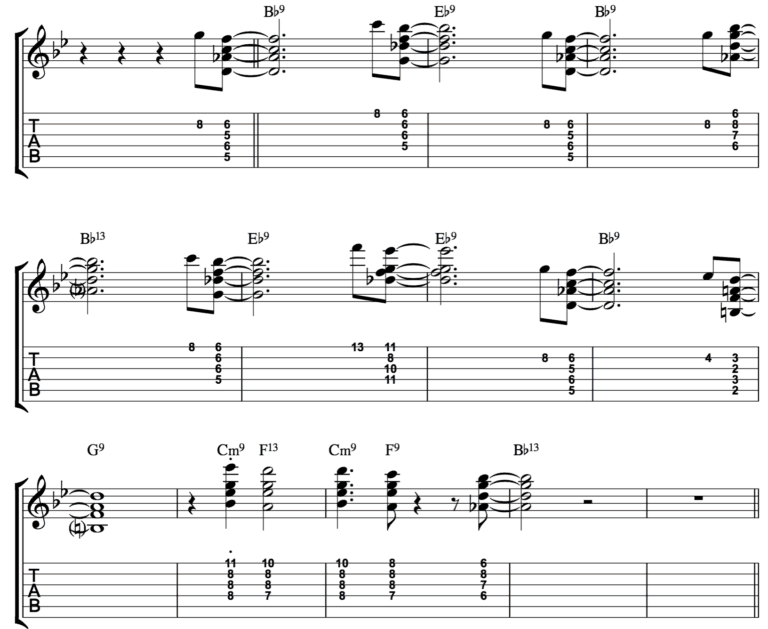
Step 5: Moving Melody and Chromatic Chords
Now for the last piece of the puzzle, step five we'll be adding the nice chromatic chords to ornament around what we had in the previous step.
Now I don't want to over complicate things in this lesson and explain every single chord shape in a comping study. Since you already know how I got there, you already have a big picture idea of the use of the harmony on the blues, on this B flat blues.
The important thing is to remember that we started simply, with a strong melody line. Then we added rootless chord shapes, and one more pickup note to each melody note. Then lastly here, in this step 5, we're adding nice harmonic frills around the basic chords of the blues. It's crucial that you see the forest before the trees and don't try to analyze every chord shape in a classical music theory sense. The added chords are play for color and sound, not because they are "grammatically correct" in a harmonic sense.
Chromatic Chords?
Quick note though, about all the new chords in step five. Here's how to describe them:
- They're either though of as approach-chords (by a half step). That's one way you can analyze them, half step higher.
- or you can analyze them as dominant chords with alterations. In this case, you'll read in the PDF the #5 ("sharp five") alteration is used many, many times.
Either way of thinking is fine, but I tend to think of -1- above. It's easier on my brains! :-)
Step 5 (for Real Now!)
Practice this:
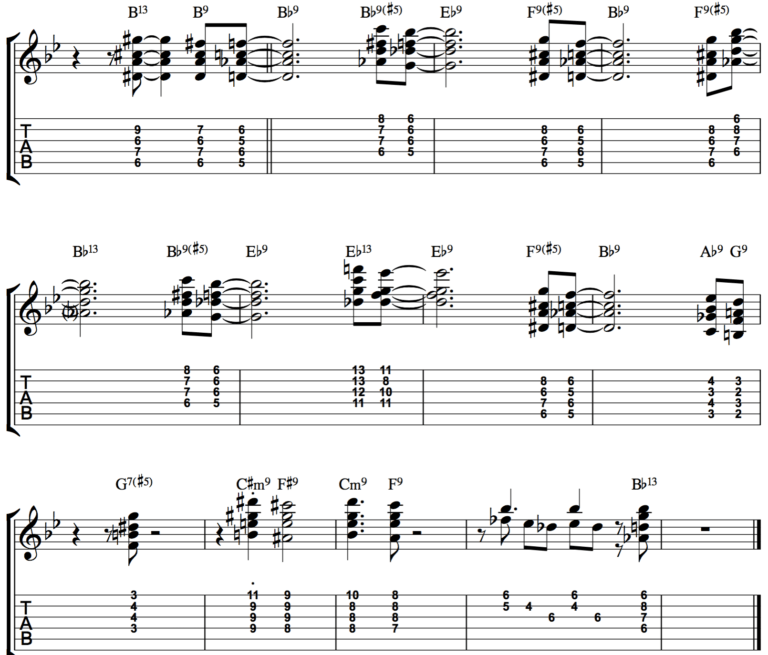
Jazz Guitar Comping: Grab Your PDF Sheet Music for This Lesson Here
Here's is the PDF file for the exercises in this lesson.
Au Revoir Jazz Guitar Comping
In conclusion, I strongly believe that this way of working with chords is pretty much the only jazz guitar comping resource you'll ever need. Try to replicate the process on tunes you're already familiar with. Build yourself an easy melody, put chords under it. Then ornament the melody, and ornament the chords. Surprise yourself!

